You will be met at the airport by our representative and introduced to your chauffeur guide who will be accompanying you on your tour.
Transfer to Kalpitiya - drive time is approximately 3.5 Hours.



Kite Surfing Kalpitiya
Kalpitiya has steadily become a popular spot for kiters of all levels in the recent years due its huge lagoons, reliable wind, and adventurous turf. The Flat water remains one of the key attractions around Kalpitiya with hair dryer-like winds that turn warm when ventured into the chest-deep lagoon in a natural cable park. Kalpitiya also has some onshore wave riding across the sandbar at Donkey Point, along with 100 kilometres of downwind space to investigate.
As a new kite destination in Asia both in the winter and the summer, Kalpitiya is ideal to learn kite surfing due to its shallow water and tranquility for kiters.
Summertime from May to October delivers strong south-west winds every day ranging from 18 to 30 knots and during these months the wind blows almost 24h a day. Winter season is from December to the end of February, and this has lighter north-west winds from 12 - 20+knots. Both seasons are however very sunny, and the changing wind direction offers different spots for kite surfing by offering a different riding place each time.



Tips on climbing Sigriya.
Avoid the crowds and humidity and be the first to climb. The time for opening may vary but do try to arrive early and be the first to enter.
Go at your pace and take plenty of water with you. Due to the steepness and the humidity it is a very strenuous climb. The first few stairways are relatively unchallenging. The fountain gardens and the Boulder gardens but don't spend too long here. They are worth a visit and you can visit after your climb down but you must stay ahead of the crowds.
The first stop is the mirror wall accessed via and the mirror stair case. The next point of interest is the frescoes. You may be tempted to skip this but don't! The narrow steep staircase is worth climbing. You won't be disappointed.
Keep going. The summit at the top where the palace was located and the views are spectacular.
Avoid the monkeys and the hornets, Bring lots of water - there are no shops enroute.
Dolphin Watching in Kalpitiya
Kalpitiya is one of the best locations in Sri Lanka for dolphin and whale watching. Kalpitiya gives you an opportunity to watch hundreds of dolphins swimming alongside and diving under your boat, riding waves, jumping, spinning, twirling and leaping out of the water in a magical display, is a magnificent experience you will never forget in your lifetime. Dolphin Watching – October (Mid October) – May.



Morning
Dolphin Watching in Kalpitiya
Transfer from Kalpitiya to Anuradhapura is approximately 2.5 hours



Jeep Safari at Wilpattu National Park
The park is situated along the Northwest coast lowland dry zone of Sri Lanka. It comprises of a unique complex of lakes called Villus, which are natural basins that are filled up with rainwater and are surrounded by open grassy plains set within dense scrub jungle. A multitude of sandy paths wind around the entire park and open up into these large natural lakes. The unspoilt and beautiful Wilpattu National Park is one of the largest and oldest National Parks in Sri Lanka. It is ideal for those wanting to escape the flurry of activity of Yala and instead offers the opportunity for a tranquil, peaceful and undisturbed drive.
The biggest draws in Wilpattu are Leopards and Sloth bears. Alongside these, it is possible to see Asian Elephants, Spotted Deer, Barking Deer, Wild Pig, Asiatic Buffalo and Mugger Crocodiles. Endemic birds include the Ceylon Junglefowl, Brown-capped Babbler, Ceylon Woodshrike and Black-capped Bulbul in riverine habitats. Muntjac or Barking Deer are more easily seen in Wilpattu than any other national park. Butterflies recorded include the Great Egg fly, Great Orange Tip, Glad-eye Bush brown, Blue Mormon, Common Mormon, Common Rose and Crimson Rose.
J



Sigiriya Rock Fortress
This is one of the most amazing historical sites of Sri Lanka and a must visit. However, take heed, the climb to the top (about 1200 steps)takes about 1-1/2 hours. Not suitable for those who are unfit or cannot deal with heights. Take a moment to read our expert tips.
Sigiriya (Lion Rock) Referred by locals as the Eighth Wonder of the World this ancient palace and fortress complex has significant archaeological importance and attracts thousands of tourists every year. It is probably the most visited tourist destination of Sri Lanka. Sigiriya rock plateau, formed from magma of an extinct volcano, is 200 meters higher than the surrounding jungles. Its view astonishes the visitors with the unique harmony between the nature and human imagination. The fortress complex includes remnants of a ruined palace, surrounded by an extensive network of fortifications, vast gardens, ponds, canals, alleys and fountains. In the 3th century BC the rocky plateau of Sigiriya served as a monastery. In the second half of the 5th century King Kasyapa decided to construct a royal residence here. After his death Sigiriya again became a Buddhist monastery until the 14th century, when it was abandoned. The main entrance is located in the northern side of the rock. It was designed in the form of a huge stone lion, whose feet have survived up to today but the upper parts of the body were destroyed. The western wall of Sigiriya was almost entirely covered by frescoes, created during the reign of Kasyapa. Eighteen frescoes have survived to this day. The frescoes are depicting nude females and are considered to be either the portraits of Kasyapa’s wives and concubines or priestess performing religious rituals. One of the most striking features of Sigiriya is its Mirror wall.
For those who are not comfortable with heights or have problems climbing we suggest the gardens of Sigiriya which are amongst the oldest landscaped gardens in the world. They are located in the western part of the rock with bridges, fountains, as well as surface and underground water pumps.
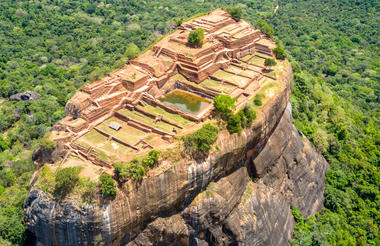
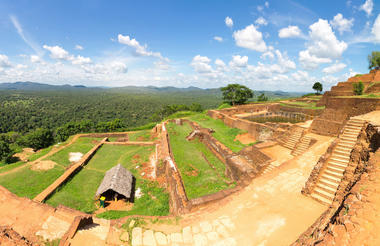
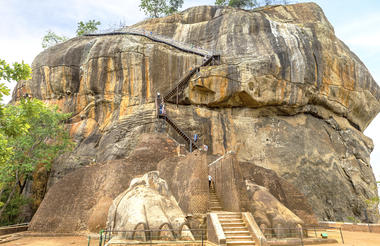
Tips on climbing Sigriya.
Avoid the crowds and humidity and be the first to climb. The time for opening may vary but do try to arrive early and be the first to enter.
Go at your pace and take plenty of water with you. Due to the steepness and the humidity it is a very strenuous climb. The first few stairways are relatively unchallenging. The fountain gardens and the Boulder gardens but don't spend too long here. They are worth a visit and you can visit after your climb down but you must stay ahead of the crowds.
The first stop is the mirror wall accessed via and the mirror stair case. The next point of interest is the frescoes. You may be tempted to skip this but don't! The narrow steep staircase is worth climbing. You won't be disappointed.
Keep going. The summit at the top where the palace was located and the views are spectacular.
Avoid the monkeys and the hornets, Bring lots of water - there are no shops enroute.
Morning
Transfer from Anuradhapura to Troncomalee. Approximate drive time is 2.5 hours.



Whale & Dolphin Watching
Whale and dolphin watching in Sri Lanka is one of the island’s biggest seasonal attractions. The waters off the coast of Jungle Beach offer some of the best spots in the world to catch a glimpse of the world’s largest ever mammal – the Blue Whale.
Furthermore, the deepest diving whales and the largest predators on Earth – Sperm Whales – are also plentiful in these parts and are often spotted traveling in super pods of 40 or more. These bountiful waters are also feeding grounds for large numbers of Spinner Dolphins who are known for their joyous acrobatic displays.
- Time of Departure – At 5:30 am from May to October
- Duration – Three-and-a-half hours including approximately one-and-a-half hour travel time
- Distance – Approximately 40 nautical miles to reach whale watching location
- What is included – Boat ride to whale sighting location & back, water bottles.
- What to bring/wear – Comfortable and cool clothes covering entire body if possible, sun hats, and your waterproof camera
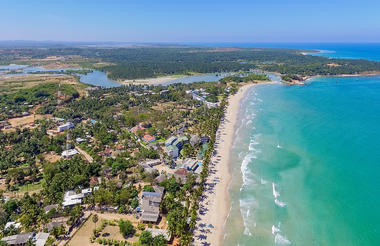
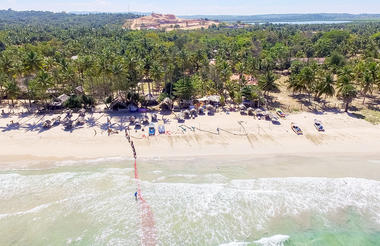
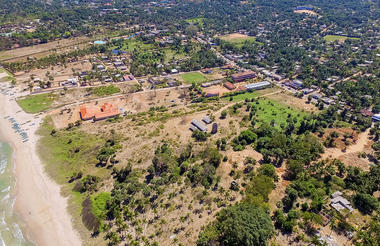
Morning
Snorkeling Nilaveli/Trincomalee
Go snorkeling in Pigeon Island marine sanctuary off the coast of Nilaveli/Trincomalee. About 16 km further north you’ll find yourself in “Nilaveli” beach with the famous Pigeon Island, the corals around the island is a great place to snorkel in our opinion and red rocks lying just 2 km offshore are reachable by small boat.
More recently though, the island has become famed for snorkeling and diving as it is a hotbed of hundreds of species of coral and around 200 species of dazzling fish. The spectacular Blacktip Reef Shark and several kinds of turtles including the Hawksbill Turtle and Green Turtle often visit this island. A must-do activity in Trincomalee.
Next, you will visit the Fort Frederick, which was built by the Portuguese in 1623, after they demolished Koneshwaram Temple in 1622.
You can also visit the seven hot springs at Kanniya, which are also known for their therapeutic properties.



Morning
Transfer to Pottuvil from Nilaveli. Drive time is approximately 5 hours.



Arugam Bay Surfing
The focus of surfing in Sri Lanka is in the East Coast of Arugam Bay, which is on the coastline of a little fishing village. The most famous place to surf is Main Point and this is directly in Arugam Bay, whilst the other surf spots are between 10 - 60 minutes of drive time away from the town center.
The Main Point however is the home surf spot as it gets its name from the most famous wave in Arugam Bay. Main Point is good for intermediate to advanced surfers as it is one of the toughest spots in the area to surf as it has a long ride that often comes with barrels, and was once voted among the top 10 world's best surfing waves. We'd recommend that you bring good footwear to avoid cuts from the reef.
Main Point is also accessible for longboarding, and next to it is Baby Point where the wave ends. This area is more protected as it is located in the corner of the bay and is an ideal place for beginners to gain more experience as you can easily rent a board at the beach there. However Baby Point gets quite crowded in the mornings or at 4pm when crowds gather for surfing lessons that take place.
Peanut Farm Arugambay
The area was once known to be home to peanut farms and plantations along the coast but was destroyed during the tsunami of 2004. One of the off the beaten track break points of Arugam Bay is at the Peanut Farm where you can experience some good swells and surfing with views of the Indian ocean as well as enjoyable swimming. There are two beach breaks where one beach has gentle waves that is suitable for beginners, whilst the other has some challenging swells that are ideal for intermediate or advanced surfers.
Even for those are not into surfing, the Peanut farm beach is quiet place for a swim or a stroll down the beach.



Morning
Afternoon
Okanda
Okanda has one of the most unspoilt beaches in Sri Lanka without hotels. It is just North of the Kumana National Park and the sea is usually too rough for safe bathing, however is a popular surfing spot by the surfers of Arugam Bay. It is a less crowded surf point where three surf breaks are really ideal for intermediate or more advanced surfers as waves rise up to 8 feet there with strong rip currents that can hurl surfers onto the rocks. Okanda is also a very remote place without any life guards and is an hour away from the town of Arugam Bay and is a small east coast hamlet, but are known for its sea waves of 0.5–1.5m (2–5ft) with breaks that can reach 1.8m–2.4m (6–8ft) and recommended for advanced surfers.
Okanda also has a revered site with a rock shrine which is a popular place for pilgrims from all parts of Sri Lanka. It is located in the Kumana Panama Jungle path and is believed to be the location where a Deity named Skanda first sailed into Sri Lanka in a golden boat. There is a grand festival held in July in Deity Skanda's honour.
Pottuvil Point
Next is the Pottuvil Point, which is a 15 - 20 minute drive through the Pottuvil town. The beach like many beaches in Arugam Bay is a fishing beach, therefore you would most likely share a spot with the fishermen and their fishing boats. Sometimes there can be an elephant around the beach, and the area is one of natural beauty due to its rocks, palm trees and untouched landscape.
Whiskey Point
Another spot to surf is called Whiskey Point, which again is about a 20 minute drive away from Arugam Bay. This is a long and wide beach with the waves that breaks at a rock constellation. It is a popular wave that is well used by beginners and intermediates, though there are a lot of sand movements over the year which can create hard conditions at Whiskey point.



Transfer to Rosyth via Kandy and a scenic train ride to Ranmukkana railway station close to Rosyth.
Kandy was the last capital of the Sri Lankan kings, and is a World Heritage Site. The name Kandy conjures visions of splendor and magnificence. Many of the legends, traditions and folklore are still lovingly kept alive. Drive around the Kandy Lake built by the last Sinhala king Sri Wickrama Rajasinghe in 1798. Visit the Kandy town and Bazaar, the arts & crafts centre and a gem museum and a lapidary. In the evening visit the Dalada Maligawa Temple of the Tooth Relic believed to have belonged to Lord Buddha himself. Thereafter witness a cultural show featuring traditional Sri Lankan dancing.
The City is perhaps most famous for the annual Perahara, a most magnificent site which sees the scared tooth relic take to the streets accompanied by dancers, drummers and most significantly elephants dressed in all their finery and adorned with lights. The parade which goes through the streets of Kandy builds into a spectacular procession over ten consecutive nights with the number of elephants growing each night. Taking place annually at the end of July and in early August, with the date dependent upon the timing of the full moon, this is truly an experience not to be missed if your timing permits. The Kandy Perahara is considered to be one of the most spectacular pageants in Asia. During the Perahara, accommodation is at a premium in Kandy and needs to be reserved well in advance.
Kandy is also famous for the Peradeniya Royal Botanical Gardens - this botanical garden was first built as a pleasure garden by a Sinhala king and was expanded by the British during the period of colonial rule. It is 147 acres in extent and provides an amazing variety of trees, plants and flowers. It is also possible to have a guided tour of the spectacular botanical gardens with a botanist tour guide, for an extra cost.
Train from Kandy to Rabukkana
The train journey is on the bucket list of most travellers to Sri Lanka. Why is the Kandy to Ella train journey so amazing? The views on both sides of the rail are breathtaking but it is a journey on one of the most charmingly decrepit railway systems in the world which reinforces the desire to travel in a modicum of discomfort!
If you are not traveling to the High tea country, this hsort journey gives you an opportunity to experience the trains. At Rambukkana, the line begins a steep climb into the hills. From Rambukana to Kandy, at Kadugannawa the track runs along the edge of sheer cliffs, allowing passengers a view of Batalegala (Bible Rock). Your guide will drop you at the station and wait until you have boarded the before driving to meet you in Kandy. The train for this portion may be quicker than the drive.



White Water Rafting
An early start to Kithulgala (2 hour drive) White water rafting in Kithulgala - One of the most popular destinations for rafting in Sri Lanka is Kithulgala, situated on the road from Colombo to Hatton. Made famous when it was chosen as a prime location in the filming of the 1957 award winning film 'Bridge on the River Kwai.' The Kelani River flows through the Kitulgala's rock strewn sections and the rapids provide ample pleasure for anyone seeking a rafting experience. The actual run takes about 1 ½ hours to 3 hours depending on how much time you want to spend in water, during which you encounter grade 2 and 3 rapids, bearing unique names such as Butter Crunch, Killer Falls, Head Chopper and Virgin's Breast.
The river's clear water tumbles through a rocky gorge just above Kithulgala. As the river widens, the river passes the scenic location used for the film -(“Bridge over the river Kwai”), which is also a great place to jump in for a refreshing swim. For those who would like to enjoy the river and its wonderful scenery without the thrills and spills of large rapids, rafting is possible through the flatter section of the lower gorge, suitable for children over six and family groups.



Morning
Rosyth Artisanal Tea Experience
An Unique Complete Tea Experience of Leaf to Cup which will take place over two days. Join our ladies in the tea gardens to pluck a leaf; the green leaf is left to wither overnight at the micro factory and the next day, they can be hand rolled, fermented, dried and packed to take home. All proceeds will be given to the Rosyth Foundation which supports the local community and school.
Rosyth Estate House Tea
For decades the Rosyth Estate single origin tea had been processed at the local factory at the top our hill, which had been in operation since 1930. At 1,000 feet above sea level, the handpicked tea is used to produce orange pekoe in different grades and fannings, with the highest grade referred to as OP. Top quality pekoe grades consist mainly of buds and grading is based on the size of the individual leaves sorted in the finishing process. The size and the wholeness of the leaves has the greatest influence on the taste, clarity, and brewing time of the tea.
The Original 1930 Rosyth Tea Factory was not owned by the Rosyth Estate House and has been independently operated for generations. Unfortunately, following a tragic fire that took place in April 2022, the factory was destroyed leaving many in the local community without employment.
Rosyth Artisanal Tea – Their tea journey
At Rosyth, determined to move away from the traditional methods of producing tea that have remained the same since the colonial era, the owners have begun their journey to become an organic, artisanal producer of Sri Lankan tea. Removing much of the mechanisation from the processes they have started to produce hand crafted teas. The leaves are carefully manipulated by rolling or pounding on the estate by their local artisans. The micro factory was constructed in the first quarter of 2023 and they moved into production in the second quarter of 2023. The artisanal
This project is wholeheartedly community focused, as they look to improve the economic sustainability of the valley. Each and every person connected to production of the tea is now a partner with a stake in the future success. The partners will receive a guarantee of 10% of the estate tea revenues as a dividend payment on top of their wages. In the coming years, they hope the initiative will vastly increase the prosperity of our local community with the skills and investment to help it flourish. Artisanal Tea can be sold for
The process follows the classic steps of tea production but with an all together more personal and hands on approach:
Step one – Plucking: the fresh leaves are plucked by hand by our skilled tea pickers. For our highest quality hand rolled artisanal teas we delicately pick just one leaf and a young bud, carefully separating the slightly larger leaf which is hand processed separately. On arrival in the factory, the leaf is further inspected & any stalks removed.
Step two – Withering: the leaves are carefully laid out on withering trays, locally know at “Tats”. Tea leaves, even fresh tender ones are not pliable and would shatter when rolled and shaped. Drying gently on the tats, the leaf is left for up to 20 hours to gently wither, loosing up to 35% of its moisture content. As it withers, the leaf is gently turned to allow an even exposure to the air.
Step three – Hand Rolling: the withered leaves are now gently rolled by hand in wicker baskets by our artisans to gently break the cell structure of the leaf and to release the enzymes & natural oils within the leaf. Natural juices are slowly released, and the leaf becomes slightly sticky to the touch. Taking up to two hours to complete care is taken to maintain the structure of the leaf.
Step four – Oxidation: after completing the rolling, the leaf is left for up to two and half hours to allow oxidation to take place. This is the critical part of the process where the air interacts with the now exposed enzymes, heat is produced, and the flavour of the tea fully develops. The leaf turns a reddish-brown colour as the chemical composition changes & the wonderfully complex flavours of our tea develop. The time taken for oxidation varies, depending on a number of factors including the air temperature and the humidity levels, but as the chemical reactions develop and temperatures around 43c are reached, it is time to stop the oxidation and dry the tea.
Step five – Firing: time is now the essence, the tea needs to be dried, the oxidation process stopped, and leaves dried to perfection. In our artisan factory the leaf is spread onto the trays and placed into a drying over at temperatures between 85-110c. Good even drying, with low residual moisture levels, is essential to being able to store the tea, typically reached in one & a half hours.
Step six – Grading and sorting: once dried, the clock stops ticking and we can be more relaxed with final sorting and grading of the tea. Our highest quality OP grades are carefully sorted, before all the teas are packed into airtight foil bags to maintain the optimum freshness. Nothing is wasted, the small leaf particles carefully separated and blended to produce lower grade teas – in large commercial factories this would often end up in tea bags!
Guided Rosyth Estate Walk
A member of our team can guide you through the Estate and give you an appreciation of rural Sri Lankan life as you wind through paddy fields, jungle, fresh water streams and meet local villagers on the way. If he is not available, one of the hotel or estate team will accompany you on a guided at approximately 4pm. You may be joined by other guests,
Rosyth is a small working estate. Tea is plucked by hand and hand crafted into the artisanal tea factory. Latex is tapped by scoring the tree, then collected and and sold to a local rubber factory. Coconuts, fruits, spices and vegetables are grown on the estate and used at the hotel. You will be amazed by the variety of produce that grows on the estate!
If you prefer to walk on your own ask the team for some directions and enjoy forest bathing: immerse in nature .The Estate and its surroundings contain beautiful walking trails & mountain biking routes over the rolling hills. Guests are free to explore the estate and join the ladies plucking tea. Guides for two of our local walking trails, so you can independently explore the beautiful part of Sri Lanka’s Low Tea Country.



Morning
Afternoon
Returning to the UK
Today you will be transferred to the Airport for the departure flight. Our local representative or driver will be in touch to confirm the pickup time a day before your departure. We normally recommend aiming to be at the Airport 3 hours prior to departure.
The drive time to the Airport is approximately 2.5 hours.




